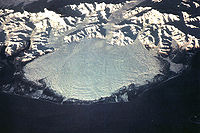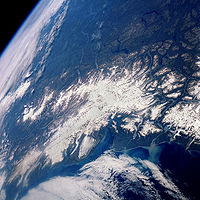- Malaspina Glacier
-
Malaspina Glacier imaged from STS-28.

 This 1994 photo from STS-66, on a rare clear day, is of an area about 100 kilometres (62 mi) across.
This 1994 photo from STS-66, on a rare clear day, is of an area about 100 kilometres (62 mi) across.
The Malaspina Glacier in southeastern Alaska is the largest piedmont glacier the world. Situated at the head of the Alaska Panhandle, it is about 65 km (40 mi) wide and 45 km (28 mi) long, with an area of some 3,900 km2 (1,500 sq mi). It is named in honor of Alessandro Malaspina, an Italian explorer in the service of the Spanish Navy, who visited the region in 1791. In 1874, W.H. Dall, of what is now the U.S. National Geodetic Survey, bestowed the name "Malaspina Plateau" on it, not realizing its true geological character.[1]
It arises where several valley glaciers, primarily the Seward Glacier and Agassiz Glacier, spill out from the Saint Elias Mountains onto the coastal plain facing the Gulf of Alaska between Icy Bay and Yakutat Bay. Although it fills the plain, nowhere does it actually reach the water and so does not qualify as a tidewater glacier.
The Malaspina is up to 600 metres (2,000 ft) thick in places, with the elevation of its bottom being estimated to be as much as 300 metres (980 ft) below sea level.[citation needed] There are two lakes on its margins: Oily Lake to the northwest, at the foot of the Samovar Hills between the Agassiz and Seward glaciers, and Malaspina Lake to the southeast, close to Yakutat Bay.
Radar data and aerial photographs dating back to 1972 provide evidence that the Malaspina-Seward glacier system lost about 20 m (66 ft) of its thickness between 1980 and 2000; because the glacier is so large, that amount of shrinkage was sufficient to contribute 1/2 of one percent of the rise in the global sea level.[2]
Nearly all of the glacier is encompassed by the southeast lobe of the Wrangell-St. Elias National Park and Preserve.
In October 1969, the glacier became a National Natural Landmark.
Contents
See also
Notes
Bibliography
- Rozell, Ned. 2000 February 2. "Malaspina Melting, But Still Bigger than Rhode Island". Alaska Science Forum, Article #1476. Geophysical Institute, University of Alaska Fairbanks.
External links
- NPS page with more pictures. Includes link to an interactive map.
Coordinates: 59°55′09″N 140°31′58″W / 59.91917°N 140.53278°W
Categories:- Glaciers of Alaska
- National Natural Landmarks in Alaska
- Landforms of Yakutat City and Borough, Alaska
- Wrangell–St. Elias National Park and Preserve
Wikimedia Foundation. 2010.

